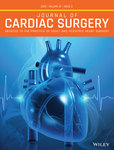Late onset atrial fibrillation in patients undergoing surgical aortic valve replacement
Abstract
Objective
Aortic valve disease is a risk factor for atrial fibrillation (AF), and AF is associated with increased late mortality and morbidity after cardiac surgery. The evolution of alternative approaches to AF prophylaxis, including less invasive technologies and medical therapies, has altered the balance between risk and potential benefit for prophylactic intervention at the time of surgical aortic valve replacement (SAVR). Such interventions impose incremental risk, however, making an understanding of predictors of new onset AF that persists beyond the perioperative episode relevant.
Methods
We conducted a retrospective single-institution cohort analysis of patients undergoing SAVR with no history of preoperative AF (n = 1014). These patients were cross-referenced against an institutional electrocardiogram (ECG) database to identify those with ECGs 3–12 months after surgery. Logistic regression was used to identify predictors of late AF.
Results
Among the 401 patients (40%), who had ECGs in our institution 3–12 months after surgery, 16 (4%) had late AF. Patients with late AF were older than patients without late AF (73 vs. 65, p = .025), and underwent procedures that were more urgent/emergent (38% vs. 15%, p = .015), with higher predicted risk of mortality (2.2% vs. 1.3%, p = .012). Predictors associated with the development of late AF were advanced age, higher preoperative creatinine level and urgent/emergent surgery.
Conclusions
The incidence of late AF 3–12 months after SAVR, is low. Prophylactic AF interventions at the time of SAVR may not be warranted.
CONFLICT OF INTERESTS
The authors declare that there are no conflict of interests.




